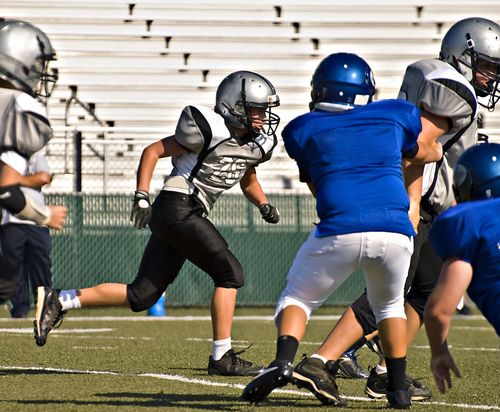
Every 13 minutes, someone in the U.S. is treated at an emergency room for a sports-related eye injury, according to the National Eye Institute. Prevent Blindness America has designated September as Sports Eye Safety Month in hopes of reducing these very serious and often preventable injuries.
Students and Sports Eye Injuries
Back to school means back to sports for many students. Here’s what parents of the most avid athletes need to know so that we can all be prepared in case of an unexpected emergency.
Racquet sports, basketball and baseball are considered to be the highest risk sports for eye injury because of high-velocity projectiles. Boxing and martial arts sports are especially high risk for direct contact to the eye with a closed fist, glove or finger; though soccer, basketball and other sports are not immune to these kinds of injuries as well.
Protective polycarbonate lenses provide the best insurance against sports-related eye injuries. Polycarbonate is an impact-resistant plastic that is especially shatter-proof and protects the eyes up to ten times more effectively than other plastics. In baseball, hockey, football and other sports where protective helmets and facemasks can be worn, make sure these are also manufactured with polycarbonate material.
It is important to note that ordinary vision-correcting glasses and contact lenses offer little to no eye protection, and in certain sports, may actually increase the risk of injury during sporting activities. Contact lenses are especially troublesome during water sports where, without goggles, they can amplify the risk of blinding eye infections with water-borne bacteria.
Common Sports Injuries
The sports that produce the most eye injuries are basketball, water and pool activities, baseball and softball, and football, according to Prevent Blindness America. Common injuries include:
- Eye infection
- Blunt trauma
- Corneal abrasion
- Eye socket fracture
- Detached retina
- Traumatic cataract
While some sports eye injuries are minor, in the most severe cases, they can lead to permanent loss of vision.
Seek medical care with any of these symptoms of moderate to severe eye injury:
- Blurred vision in the affected eye
- Double vision
- Aching / throbbing pain in or around the eye
- Scratchy / sandy irritation on the eye surface with blinking
- Pain with eye movement
- Seeing new flashing lights, floaters, or cobwebs from the affected eye
Evidence of the following signs on your athlete’s eye also require urgent evaluation:
- Limited vertical or lateral eye movement in the affected eye
- Laceration or cut in or around the eyelid
- Bruised or protruding eye / orbit
- “Cat eye” / abnormal pupil
- Layering of blood behind the eye’s clear center
What To If an Eye Injury Occurs
DO NOT touch the eye or try to fix anything yourself. If you have access to a protective shield or the bottom of a styrofoam cup, these can be taped to cover the eye until you can reach medical care.
Where Do I Go for Treatment of Sports Eye Injuries?
During weekday hours, you’ll receive the most timely and specialized care by bypassing the emergency room and heading straight for the nearest eye care provider. Berkeley Eye Center, for example, has 20 offices in and around Houston and can accommodate patients without prior appointment.
After hours, if you’re already established at an eye care practice, contact their answering service for further guidance. Otherwise, head to the emergency room.
Keep in mind, not all emergency rooms are created equal in terms of ophthalmology coverage. Most corner 24-hour emergency centers are ill-equipped for eye care. An emergency room at a at large university medical center is more likely to have dedicated ophthalmology coverage, and you may consider a confirmation phone call while en route to avoid any delays in care or hospital-to-hospital transfers.
Special considerations
- Athletes with a history of previous eye surgery, including LASIK, are more prone to serious eye injuries and should wear polycarbonate protective lenses to protect the integrity of the surgery, even if it was done several years prior.
- Any athlete with visual limitation in one eye should wear polycarbonate protective lenses at all times to protect the better-seeing eye.
Preventing Sports Eye Injuries
Proper eye protection can prevent many of the eye injuries listed above. Particularly for children, the support of parents, coaches, school administrators, and others are needed to make sure children are playing sports as safely as possible.
Some sports carry a greater risk for eye injury than others. The National Eye Institute breaks them down into three categories: high risk sports, moderate risk sports and low risk sports.
- High risk sports: Baseball (the leading cause of eye injury for children 14 and under), basketball, boxing, hockey, paintball, racquetball, softball, fencing
- Moderate risk sports: Football, golf, tennis, soccer, fishing
- Low risk sports: Bicycling, diving, skiing, walking, jogging, swimming, wrestling
Protective eyewear for sports should be made of an ultra-strong polycarbonate composite material and should always be worn while participating in sporting activities with a high or moderate risk for eye injuries. Polycarbonate eyewear is 10 times more impact resistant than regular plastics and does not reduce vision.
For the best protection, you should select protective eyewear labeled as ASTM F803 approved. Depending on the activity, a face guard or helmet may also be required to protect the face and head along with the eyes. Your eye care professional can recommend the most appropriate type of protective eyewear for your chosen sport.
Glass lenses and contact lenses do not provide adequate protection and should not be worn when participating in sports. IF you wear eyeglasses, you should use prescription protective sports eyewear fitted by an eye care professional.
Even though the risk of eye injury may be low in sports like cycling, skiing, swimming and jogging, wearing protective eye gear is still a good idea. Sunglasses are recommended for all outdoor activities to reduce glare, block potentially harmful UV radiation and help protect the eye from airborne dust and other particles. Swim goggles and swim masks improve visibility and reduce the chances of eye irritation from salty sea water or overly chlorinated pool water.
Get Help Choosing the Right Protective Eyewear for Your Sports Activities
The right eye protection depends on the age of the participant and the type of sport, and the experienced optometrists and opticians at Berkeley Eye Center can help determine the right protective eyewear for your child. Contact us today to schedule an eye exam and to find the right eyewear for your families’ needs.
